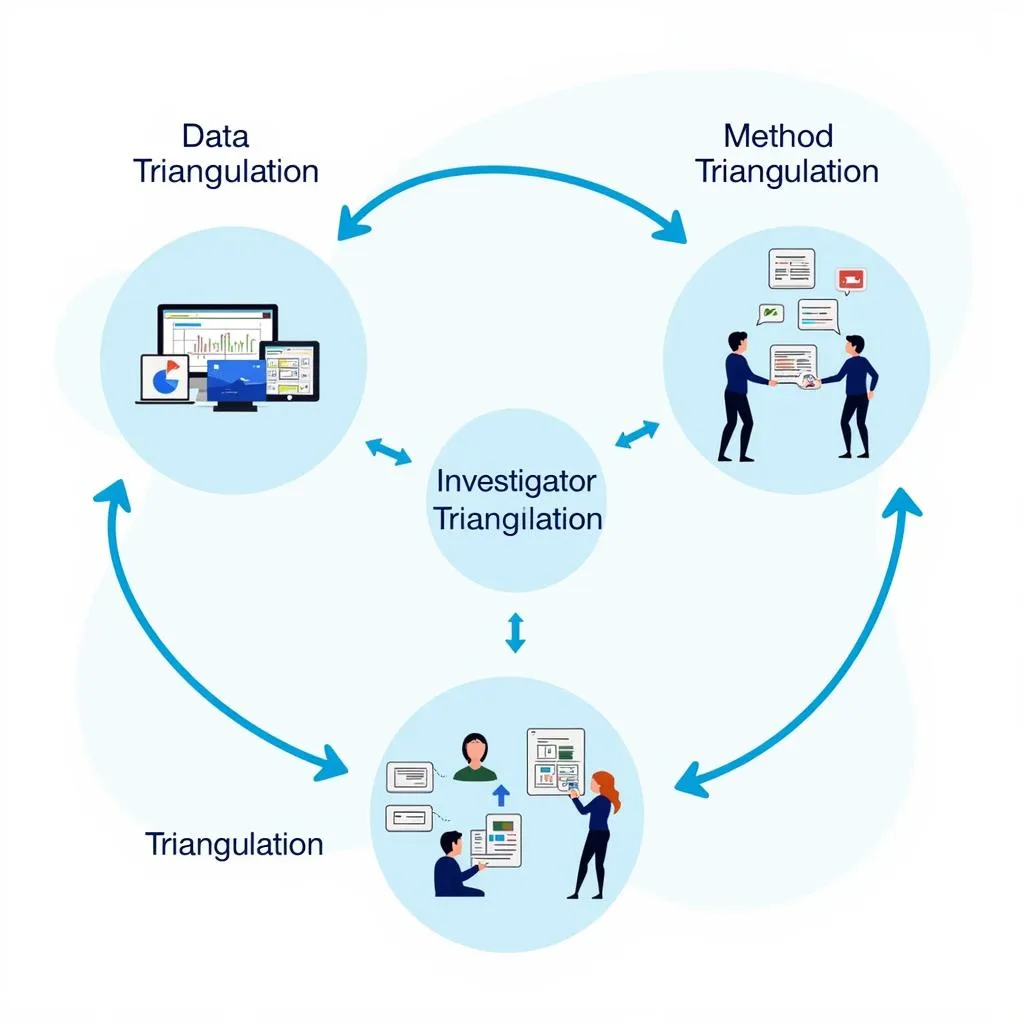The world of paranormal research is shrouded in mystery, often relying on anecdotal evidence and subjective experiences. However, a growing number of researchers are turning to rigorous qualitative methodologies, like triangulation, to bring scientific objectivity to the study of the unexplained. Triangulation Qualitative Research offers a powerful framework to examine paranormal phenomena by combining multiple data sources, methods, or theories to strengthen findings and enhance the credibility of conclusions.
Delving Deeper: What is Triangulation in Qualitative Research?
Triangulation in qualitative research involves using multiple data sources, methods, or theoretical perspectives to create a more comprehensive and robust understanding of the phenomenon under investigation. This approach helps mitigate the limitations of relying on a single source or method, allowing researchers to uncover richer insights and enhance the trustworthiness of their findings.
 Triangulation Data Sources
Triangulation Data Sources
For example, imagine investigating a purportedly haunted location. A researcher might combine interviews with eyewitnesses, historical document analysis, and on-site electromagnetic field readings. This multifaceted approach provides a more holistic understanding of the phenomena than relying solely on eyewitness accounts, which can be subjective and prone to bias.
Why is Triangulation Crucial for Paranormal Research?
The inherent subjectivity of paranormal experiences makes triangulation particularly relevant for this field. Here’s why:
- Enhancing Credibility: Triangulation strengthens the credibility of findings by demonstrating that the conclusions are not dependent on a single, potentially biased source.
- Reducing Researcher Bias: By incorporating diverse perspectives and methods, triangulation helps minimize the influence of the researcher’s preconceived notions or biases on the research process.
- Unveiling Complexities: Paranormal phenomena are often intricate and multifaceted. Triangulation allows researchers to explore these complexities from various angles, uncovering nuanced insights that might otherwise remain hidden.
The Different Types of Triangulation in Qualitative Research
Researchers utilize several types of triangulation, each with unique strengths:
- Data Triangulation: Utilizing data from different sources, such as interviews, observations, and documents, to corroborate findings.
- Method Triangulation: Employing various research methods, like interviews and surveys, to examine the same phenomenon from different angles.
- Investigator Triangulation: Involving multiple researchers in data collection and analysis to reduce individual bias and provide diverse interpretations.
 Visualizing Different Triangulation Methods
Visualizing Different Triangulation Methods
Triangulation in Action: A Case Study
Let’s imagine investigating reports of a ghostly apparition in an ancient library. A researcher might utilize triangulation in the following ways:
- Interviews: Conduct in-depth interviews with library staff, visitors who claim to have seen the apparition, and local historians familiar with the library’s past.
- Observations: Conduct nighttime observations of the library, using infrared cameras and electromagnetic field detectors to document any unusual occurrences.
- Document Analysis: Review historical records, architectural plans, and any available accounts or legends associated with the library, searching for potential explanations or connections to the reported apparition.
By integrating these diverse data sources, researchers can construct a more comprehensive and compelling understanding of the phenomenon.
Challenges and Considerations in Applying Triangulation
While triangulation offers significant advantages, researchers must be mindful of potential challenges:
- Data Discrepancies: Different data sources might yield contradictory findings. Researchers must carefully analyze these discrepancies, considering potential biases or limitations within each source.
- Resource Intensiveness: Triangulation often demands more time, resources, and expertise compared to using a single method.
“When investigating paranormal claims,” explains Dr. Evelyn Wright, a leading researcher in parapsychology, “triangulation provides a crucial framework for objective analysis. By carefully weaving together multiple lines of evidence, we can begin to separate genuine anomalies from misinterpretations or hoaxes.”
Conclusion: Triangulation as a Path to Understanding
Triangulation in qualitative research offers a rigorous and compelling approach to unraveling the mysteries of the paranormal. By embracing multiple perspectives, methods, and data sources, researchers can illuminate the unknown with greater clarity and credibility. While challenges exist, the potential rewards of uncovering hidden truths and advancing our understanding of the unexplained make triangulation an invaluable tool in the pursuit of paranormal knowledge.
FAQs about Triangulation in Qualitative Research
1. Is triangulation only relevant for qualitative research?
While predominantly used in qualitative research, triangulation can also be applied in quantitative studies to enhance the validity of findings by using multiple data sets or analytical techniques.
2. Can triangulation definitively prove or disprove paranormal phenomena?
Triangulation is not about definitive proof but about building a stronger case for or against specific claims. It provides a more robust and credible foundation for drawing conclusions but does not guarantee absolute certainty.
3. What are the ethical considerations when using triangulation in paranormal research?
Researchers must prioritize informed consent, confidentiality, and sensitivity when dealing with potentially vulnerable individuals who have experienced paranormal phenomena.
4. How can I learn more about applying triangulation in my own paranormal investigations?
Numerous resources, including books, articles, and online courses, delve deeper into qualitative research methodologies and the specific applications of triangulation.
Delve Deeper into the Paranormal
For all your Paranormal Research needs, contact us at 0904826292 or research@gmail.com. You can also visit us at No. 31, Alley 142/7, P. Phú Viên, Bồ Đề, Long Biên, Hà Nội, Việt Nam. Our team is available 24/7 to assist you.